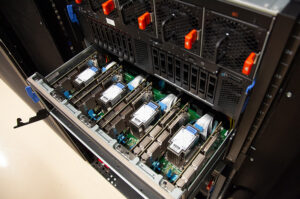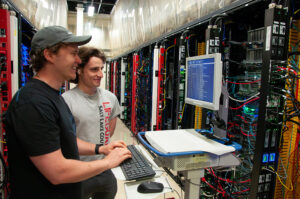U Supercharges AI Computing Power with New GPUs
The University of Utah Center for High Performance Computing recently installed its single-biggest upgrade to AI cyberinfrastructure: a fleet of 10 powerful computer servers with 80 high-end NVIDIA graphics processing units (GPUs), hardware critical for AI-driven research. This $2.15 million investment will help the center continue to support Utah researchers who are increasingly using AI to make discoveries.
“This is significant in meeting current and future needs,” said Brian Haymore, senior IT architect of compute systems at the center, better known across campus as CHPC. “The flexibility of the hardware allows us to meet a very broad range of needs at a level that we have not been able to support previously.”

The new GPUs are funded by the One-U Responsible AI Initiative (One-U RAI) at the Scientific Computing and Imaging Institute and can be used by anyone with access to CHPC, from teachers to researchers working with patient data that require additional security measures. The number of servers set up for either HIPAA-compliant work or open science can be adjusted as needed. The new servers also offer more features and performance capabilities. Big research projects—such as the Molinero Research Group’s work simulating millions of particles and their interactions—can scale across more than one of these new machines. And one machine can securely handle multiple smaller projects, such as class assignments for engineering students.
“That flexibility is specifically what drew us to this solution,” Haymore said. Another draw: thanks to the U’s partnership with NVIDIA, CHPC acquired the servers quickly and at a discounted price after a previous order fell through. Instead of waiting the typical six months for these in-demand GPUs, they arrived in under two months.
The fast-tracked upgrade is a boon for the U and beyond. Of the 1,100 principal investigators at the U, at least 900 use the center services. CHPC also supports research groups from Utah Valley University, Snow College, Weber State University, Utah Tech University, and Utah State University. That amounts to about 7,000 researchers and counting—a group that has doubled and diversified since center director Thomas Cheatham took the helm in 2014.

“It used to be just chemistry and physics, but now it's everything from sociology to education,” said Cheatham, a professor of medicinal chemistry. “To do modern research, you’ve got to have unique computational or data resources that are beyond what you have on your laptop or your desktop. We provide an expert team that can serve as the interface between the researcher and the technology and the infrastructure.”
Thanks in part to President Taylor Randall’s commitment for the U to be a national leader in AI, CHPC will continue to evolve, giving Utah researchers the computing power and data storage needed to push their fields forward. Infrastructure investments from One-U RAI will be spread over three $5 million installments. The 10 new servers are part of the first installment, which broadly aims to replace aging infrastructure and add computing and storage capacity. Future investments will add newer generations of GPUs as they are released, expanding computing resources by two to four times every other year.
Banner image: CHPC team members pose beside the new servers, left, marked by magnets with the One-U Responsible AI logo. Pictured from left, Thomas Cheatham (director), Becky Ortinez (senior project manager), Brian Haymore (senior IT architect, compute systems), Janne Wald (student technical assistant), Nico Rubio (student technical assistant), Carson Lippold (student employee), Irvin Allen (senior systems administrator, networking and infrastructure), Nick Hill (engineer, networking and infrastructure), Adri Kingston (systems administrator, compute systems), Miguel Mendoza (student technical assistant).
